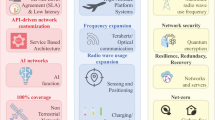Abstract
A novel optimization procedure for the location of the transmitter in \(3\times 3\) multiple input multiple output (MIMO) wireless local area network (WLAN) wireless communication systems is presented. The optimal antenna location for maximizing the channel capacity is searched by dynamic differential evolution (DDE) and genetic algorithm (GA). There are two different receiver locations considered in the simulation. The receivers are located with uniform intervals distribution either on the tables or in the whole indoor environment. Numerical results show that the performance for increasing channel capacity by DDE algorithm is better than that by GA.








Similar content being viewed by others
References
Sato, K., Ihara, T., Saito, H., Tanaka, T., Sugai, K., Ohmi, N., et al. (1997). Measurements of reflection and transmission characteristics of interior structures of office buildings in the 60 GHz band. IEEE Transactions on Antennas and Propagation, 45(12), 1783–1792.
Smulders, P. (2002). Exploiting the 60 GHz band for local wireless multimedia access: prospects and future directions. IEEE Communications Magazine, 40(1), 140–147.
IEEE Standard for Information Technology—Telecommunications and information exchange between systems—Local and metropolitan area networks—Specific requirements—Part 11: Wireless LAN Medium Access Control (MAC) and Physical Layer (PHY) Specifications—2007. IEEE Standard 802.11-2007.
Wong, A. H., Neve, M. J., & Sowerby, K. W. (2007). Antenna selection and deployment strategies for indoor wireless communication systems. IET Communications, 1(4), 732–738.
Lee, D. C. K., Neve, M. J., & Sowerby, K. W. (2007). The impact of structural shielding on the performance of wireless systems in a single-floor office building. IEEE Transactions on Wireless Communications, 6(5), 1787–1795.
Yun, Z., Kim, S., & Iskander, M. (2008). An integrated method of ray tracing and genetic algorithm for optimizing coverage in indoor wireless networks. IEEE Transactions on Antennas Wireless Propagation Letters, 7, 145–148.
Grubisic, S., Carpes, W. P., Jr, & Bastos, J. P. A. (2009). Optimization model for antenna positioning in indoor environments using 2-D ray-tracing technique associated to a real-coded genetic algorithm. IEEE Transactions on Magnetics, 45(3), 1626–1629.
Chen, S. H., & Jeng, S. K. (1995). An SBR/image approach for indoor radio propagation in a corridor. IEICE Transactions on Electronics, E78, 1058–1062.
Chen, S. H., & Jeng, S. K. (1996). SBR image approach for radio wave propagation in tunnels with and without traffic. IEEE Transactions Vehicular Technology, 45, 570–578.
Zhao, Y., Hao, Y., Alomainy, A., & Parini, C. (2006). UWB on-body radio channel modeling using ray theory and subband FDTD method. IEEE Transactions Microwave Theory and Techniques, 153(1), 120–126 (2006).
Zhang, Y., & Brown, A. K. (2006). Complex multipath effects in UWB communication channels. IEE Proceedings Communications, 153(1), 120–126.
Richardson, P. C., Xiang, W., & Stark, W. (2006). Modeling of ultra-wideband channels within vehicles. IEEE Journal on Selected Areas in Communications, 24(4), 906–912.
Driessen, P. F., & Foschini, G. J. (1999). On the capacity formula for multiple input-multiple output wireless channels: A geometric interpretation. IEEE Transations on Communications, 47(2), 173–176.
Tila, F., Shepherd, P. R., & Pennock, S. R. (2004). Theoretical capacity evaluation of indoor micro- and macro-MIMO systems at 5 GHz using site specific ray tracing. 6th Electronics Letters, 39(5), 471–472.
Oh, S. H., & Myung, N. H. (2004). MIMO channel estimation method using ray-tracing propagation model. 14th Electronics Letters, 40(21), 1350–1352.
Loredo, S., & Rodríguez-Alonso, A. (2008). Indoor MIMO channel modeling by rigorous GO/UTD-based ray tracing. IEEE Transactions on Vehicular Technology, 57(2), 680–692.
Chen, S. H., & Jeng, S. K. (1997). An SBR/image approach for radio wave propagation in indoor environments with metallic furniture. IEEE Transactions on Antennas Propagation, 45(1), 98–106.
Balanis, C. A. (1989). Advanced engineering electromagnetics. Hoboken: Wiley.
Iskander, M. F., & Yun, Z. (2002). Propagation prediction models for wireless communication systems. IEEE Transactions on Microwave Theory and Technique, 50(3).
Oppermann, I., Hamalainen, M., & Iinatti, J. (2004). UWB theory and applications. Hoboken: Wiley.
Kamen, E. W., & Heck, B. S. (2000). Fundamentals of signals and systems using the web and matlab. New Jersey: Prentice-Hall.
Gabriella, M., Benedetto, D., & Giancola, G. (2004). Understanding ultra wide band radio fundamentals. New Jersey: Prentice Hall.
Loredo, S., & Rodríguez-Alonso, A. (2008). Indoor MIMO channel modeling by rigorous GO/UTD-based ray tracing. IEEE Transactions on Vehicular Technology, 57(2), 680–692.
Malik, W. Q., Stevens, C. J., & Edwards, D. J. (2007). Spatio-temporal ultrawideband indoor propagation modeling by reduced complexity geometric optics. IEET Communications, 1(4), 751–759.
Strang, G. (1988). Linear algebra and its applications. San Diego: Harcourt Brace Jovanovich.
Balanis, C. A. (1989). Advanced engineering electromagnetics. USA: Wiley.
Xu, Z., Sfar, S., & Blum, R. S. (2009). Analysis of MIMO systems with receive antenna selection in spatially correlated Rayleigh fading channels. IEEE Transations on Vehicular Technology, 58(1), 251–262.
Chang, W.-J., T, Jenn-Hwan, & Peng, S.-Y. (2008). Frequency-space-polarization on UWB MIMO performance for body area network applications. IEEE Antennas and Wireless Propagation Letters, 7, 577–580.
Valenzuela-Valdés, J. F., García-Fernández, M. A., Martínez-González, A. M., & Sánchez-Hernández, D. A. (2008). The influence of efficiency on receive diversity and MIMO capacity for Rayleigh-fading channels. IEEE Transactions Antennas and Propagattion, 56(5), 1444–1450.
Storn, R., & Price, K. (1995). Differential evolution—a simple and efficient adaptive scheme for global optimization over continuous spaces. Technical Report TR-95-012, International Computer Science Institute, Berkeley.
Goldberg, D. E. (1989). Genetic algorithm in search optimization and machine learning. Boston: Addison Wesley.
Johnson, J. M., & Rahmat-Samii, Y. (1997). Genetic algorithms in engineering electromagnetics. IEEE Antennas and Propagation Magazine, 39(4), 7–21.
Rappaport, T. S. (2002). Wireless communications: Principles and practice 2nd ed. Upper Saddle River, NJ, USA: Prentice Hall PTR.
Author information
Authors and Affiliations
Corresponding author
Rights and permissions
About this article
Cite this article
Liao, SH., Chiu, CC. & Ho, MH. Comparison of Dynamic Differential Evolution and Genetic Algorithm for MIMO-WLAN Transmitter Antenna Location in Indoor Environment. Wireless Pers Commun 71, 2677–2691 (2013). https://doi.org/10.1007/s11277-012-0963-1
Published:
Issue Date:
DOI: https://doi.org/10.1007/s11277-012-0963-1




